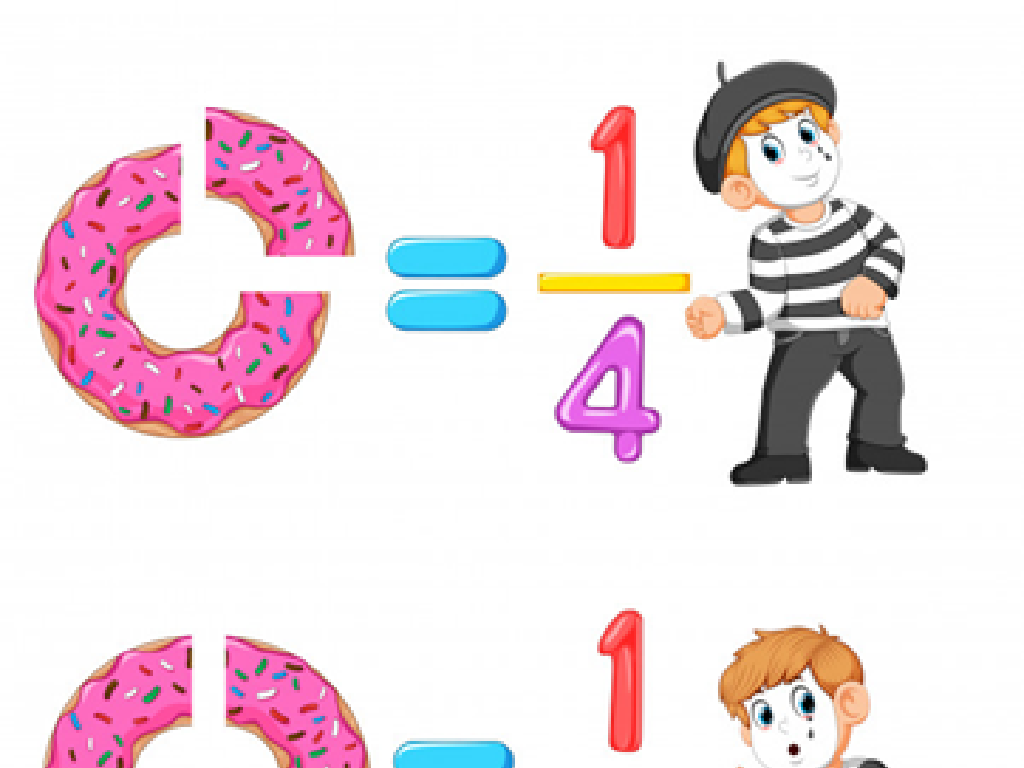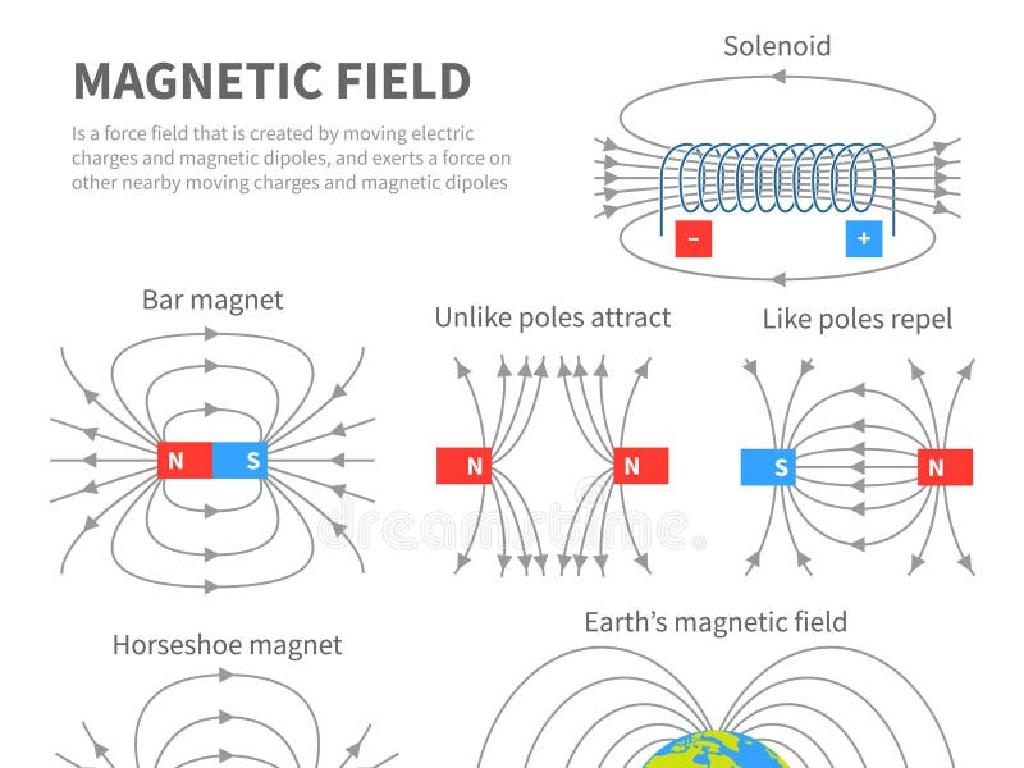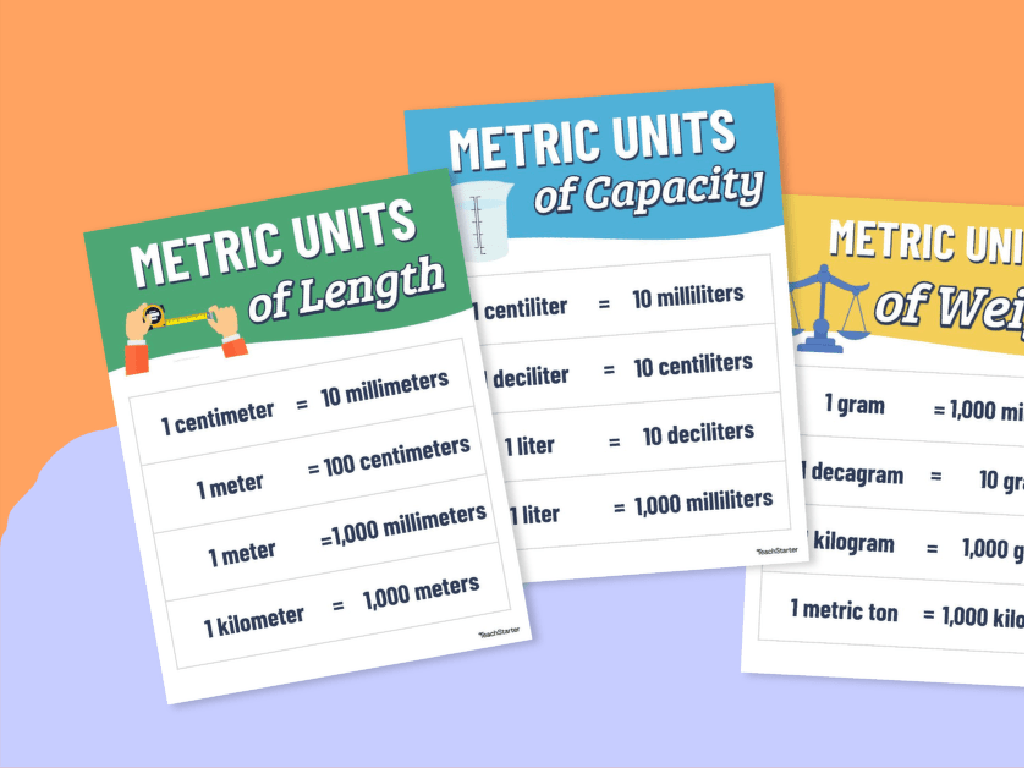Circumference Of Circles
Subject: Math
Grade: Seventh grade
Topic: Perimeter And Area
Please LOG IN to download the presentation. Access is available to registered users only.
View More Content
Exploring Circumference of Circles
– Perimeter vs. Area: A Recap
– Perimeter is the boundary length; area is the space inside.
– Today’s Focus: Circumference
– Circumference is the perimeter for circles, measured in linear units.
– Circumference: Circle’s Perimeter
– It’s the distance around the circle, calculated using À (Pi).
– Differentiating Circumference and Area
– Circumference is a one-dimensional measure; area is two-dimensional.
|
Begin with a brief review of perimeter and area to set the stage for today’s lesson on circumference. Emphasize that while perimeter and area both describe aspects of shapes, they serve different purposes. Introduce circumference as a specific type of perimeter that applies to circles. Explain that circumference is measured in linear units (such as inches or centimeters) and is calculated using the constant À (Pi), which relates the diameter of the circle to its perimeter. Highlight the difference between circumference (a linear measure around the shape) and area (a measure of the space contained within the shape). Use diagrams to illustrate these concepts and provide examples of calculating the circumference using the formula C = Àd or C = 2Àr, where d is the diameter and r is the radius of the circle.
Exploring the Circumference of Circles
– Circumference: circle’s perimeter
– The total distance around a circle, similar to the perimeter of a polygon.
– Comparing circumference and perimeter
– Unlike straight-edged perimeters, circumference measures the boundary of a round shape.
– Circumference in daily life
– Examples: bicycle wheels, plates, and coins.
– Calculating circumference
|
This slide introduces the concept of circumference as it relates to circles, distinguishing it from the perimeter of polygons. Emphasize that while both terms describe the distance around a shape, ‘circumference’ is specific to circles. Use everyday objects as relatable examples to help students visualize and understand the concept. Additionally, demonstrate how to calculate the circumference using the formula C = Àd or C = 2Àr, where d is the diameter and r is the radius of the circle. Encourage students to measure and calculate the circumference of objects around the classroom or at home to reinforce the concept.
Circumference of Circles
– Circumference formula: C = Àd
– C represents circumference, À is Pi, and d is diameter.
– Alternate formula: C = 2Àr
– Radius (r) is half of the diameter (d).
– Understanding Pi (À)
– Pi (À) is approximately 3.14 or 22/7, a constant value.
– Pi (À) in circle formulas
– Pi (À) is used to calculate the circumference and area of circles.
|
This slide introduces the fundamental formulas for calculating the circumference of a circle, which is the distance around the circle. The first formula uses the diameter, which is the straight line passing through the center of the circle. The alternate formula is based on the radius, which is half the length of the diameter. Pi (À) is a special mathematical constant that represents the ratio of the circumference of any circle to its diameter. It’s crucial for students to understand that Pi is constant for all circles and to memorize its approximate decimal value or fraction representation. Use examples like measuring circular objects to demonstrate how these formulas are applied in real life.
Calculating the Circumference of Circles
– Circumference with diameter example
– Use the formula C = Àd, where d is the diameter of the circle.
– Circumference with radius example
– Apply the formula C = 2Àr, where r is the radius.
– Practice problem instructions
– Solve for the circumference using the given measurements.
|
This slide is aimed at teaching students how to calculate the circumference of a circle using both the diameter and the radius. Start with an example where the diameter is given, using the formula C = Àd, and walk through the steps to solve for the circumference. Next, present an example using the radius, with the formula C = 2Àr. After explaining both methods, provide a practice problem for the students to solve on their own, reinforcing their understanding of the concept. Encourage students to memorize the formulas and understand the relationship between diameter, radius, and circumference. The practice problem should be a simple calculation to build confidence before moving on to more complex exercises.
Circumference in the Real World
– Circumference in daily life
– Basketball circumference example
– Standard basketball has a circumference of about 29.5 inches
– Earth’s circumference in navigation
– Circumference helps in calculating distances and travel routes
– Understanding practical applications
|
This slide aims to show students how the concept of circumference is applied in real-world scenarios, making the mathematical concept more tangible. Discuss how circumference is used in everyday life, such as in sports equipment sizing or in global navigation. For instance, knowing the circumference of a basketball can help in understanding ball control and grip. The circumference of the Earth is crucial for navigation and travel, affecting how pilots and sailors chart courses. Encourage students to think of other examples where circumference plays a role in their daily lives. This will help them appreciate the relevance of what they learn in class to the outside world.
Let’s Practice Together: Circumference of Circles
– Class activity: Measure and calculate
– Group work: Find and measure objects
– In groups, locate circular objects in the classroom
– Record object circumferences
– Use a string and ruler to measure the circumference
– Share findings with the class
– Present your measurements and discuss
|
This interactive class activity is designed to help students apply their knowledge of circumference in a practical setting. Divide the class into small groups and provide each group with a string and ruler. Students will search for circular objects around the classroom, such as clocks, jars, or hoops, and measure their circumference using the string, which they will then measure with the ruler. They should record their findings and calculate the circumference using the formula C = Àd or C = 2Àr. After the activity, each group will share their findings with the class, discussing any challenges they faced and how they overcame them. This will reinforce their understanding of the concept and allow for peer learning. As a teacher, circulate the room to provide guidance and ensure accuracy in their measurements and calculations. Prepare additional examples in case some groups finish early or struggle to find suitable objects.
Class Activity: Circumference Scavenger Hunt
– Find circles in the classroom
– Measure each circle’s diameter
Use a ruler or a string to measure across the center
– Calculate each circle’s circumference
Use the formula C = Àd or C = 2Àr, where d is diameter and r is radius
– Share your unique findings
Discuss why you found it interesting
|
This interactive activity is designed to help students apply their knowledge of the circumference of circles in a fun and engaging way. Students will search for circular objects in the classroom, measure their diameters, and then calculate the circumference using the formula C = Àd or C = 2Àr. Encourage students to work in pairs or small groups to foster collaboration. Provide rulers and strings for measuring and calculators for the calculations if necessary. After the activity, each student or group will present their most interesting find to the class, explaining the process they used to measure and calculate the circumference. This will help reinforce their understanding and allow them to see the practical application of math in everyday objects. As a teacher, be prepared to assist with measurements and calculations, and have a list of potential objects in case some students have difficulty finding items to measure.
Circumference Review & Looking Ahead
– Recap: Circumference of circles
– The distance around a circle, C = Àd or C = 2Àr
– Accuracy in measurements
– Exact measurements lead to correct calculations
– Importance of precision
– Precise measurements are crucial in real-world applications
– Next: Area of Circles
– Understanding the space inside a circle
|
This slide aims to consolidate the students’ understanding of the circumference of circles, emphasizing the formulas C = Àd (circumference equals pi times diameter) and C = 2Àr (circumference equals two times pi times radius). Highlight the importance of accurate measurements for precise calculations, which is vital in various real-world scenarios such as construction and engineering. Prepare students for the next lesson by briefly introducing the concept of the area of circles, which will explore the space inside the circle. Encourage students to think about how area and circumference are related but distinct properties of circles.






